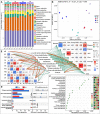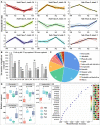Effects of nitrogen input on soil bacterial community structure and soil nitrogen cycling in the rhizosphere soil of Lycium barbarum L
- PMID: 36704567
- PMCID: PMC9871820
- DOI: 10.3389/fmicb.2022.1070817
Effects of nitrogen input on soil bacterial community structure and soil nitrogen cycling in the rhizosphere soil of Lycium barbarum L
Abstract
Lycium barbarum L., goji berry, is a precious traditional Chinese medicine and it is homology of medicine and food. Its growth is heavily dependent on nitrogen. The use of chemical fertilizers has significantly promoted the yield of goji berry and the development of the L. barbarum L. industry. However, crop plants are inefficient in the acquisition and utilization of applied nitrogen, it often leads to excessive application of nitrogen fertilizers by producers, which cause negatively impact to the environment ultimately. The exploration of an interaction model which deals with crops, chemical fertilizers, and rhizosphere microbes to improve nitrogen use efficiency, is, therefore, an important research objective to achieve sustainable development of agriculture greatly. In our study, we explored the effects of nitrogen input on soil microbial community structure, soil nitrogen cycling, and the contents of nutrients in L. barbarum fruits. The structure and composition of the bacterial community in the rhizosphere soil of L. barbarum were significantly different under different nitrogen supply conditions, and high nitrogen addition inhibited the diversity and stability of bacterial communities. Low nitrogen input stimulated the relative abundance of ammonia-oxidizing bacteria (AOB), such as Nitrosospira, catalyzing the first step of the ammonia oxidation process. The results of the GLMM model showed that the level of nitrogen fertilizer (urea) input, the relative abundance of AOB, the relative abundance of Bradyrhizobium, and their combinations had significant effects on the soil nitrogen cycling and contents of nutrients in L. barbarum fruits. Therefore, we believe that moderately reducing the use of urea and other nitrogen fertilizers is more conducive to improving soil nitrogen use efficiency and Goji berry fruit quality by increasing the nitrogen cycling potential of soil microorganisms.
Keywords: Lycium barbarum L.; bacterial community; goji berry quality; nitrogen cycle; rhizosphere soil.
Copyright © 2023 Li, Zou, Liang, Zhou, Guo, Wang, Qin, Tian and Lin.
Conflict of interest statement
The authors declare that the research was conducted in the absence of any commercial or financial relationships that could be construed as a potential conflict of interest.
Figures






Similar articles
-
Response of Chaetomium sp. to Nitrogen Input and Its Potential Role in Rhizosphere Enrichment of Lycium barbarum.Microorganisms. 2025 Aug 9;13(8):1864. doi: 10.3390/microorganisms13081864. Microorganisms. 2025. PMID: 40871368 Free PMC article.
-
Response of soil chemical properties and microbial community characteristics in Lycium barbarum orchard to planting years.Ying Yong Sheng Tai Xue Bao. 2024 Dec 18;35(12):3453-3460. doi: 10.13287/j.1001-9332.202412.018. Ying Yong Sheng Tai Xue Bao. 2024. PMID: 40383897 English.
-
Impact of Nitrogen Fertilizer Levels on Metabolite Profiling of the Lycium barbarum L. Fruit.Molecules. 2019 Oct 28;24(21):3879. doi: 10.3390/molecules24213879. Molecules. 2019. PMID: 31661883 Free PMC article.
-
Lycium barbarum (Goji) as functional food: a review of its nutrition, phytochemical structure, biological features, and food industry prospects.Crit Rev Food Sci Nutr. 2023;63(30):10621-10635. doi: 10.1080/10408398.2022.2078788. Epub 2022 May 20. Crit Rev Food Sci Nutr. 2023. PMID: 35593666 Review.
-
Yeast Synthetic Biology for the Production of Lycium barbarum Polysaccharides.Molecules. 2021 Mar 15;26(6):1641. doi: 10.3390/molecules26061641. Molecules. 2021. PMID: 33804230 Free PMC article. Review.
Cited by
-
Foliar Fertilizer Application Alters the Effect of Girdling on the Nutrient Contents and Yield of Camellia oleifera.Life (Basel). 2023 Feb 20;13(2):591. doi: 10.3390/life13020591. Life (Basel). 2023. PMID: 36836950 Free PMC article.
-
Interactive Effects of Precipitation and Nitrogen on Soil Microbial Communities in a Desert Ecosystem.Microorganisms. 2025 Jun 14;13(6):1393. doi: 10.3390/microorganisms13061393. Microorganisms. 2025. PMID: 40572279 Free PMC article.
-
Effects of water-fertiliser coupling on the photosynthesis and quality of Lycium barbarum based on predicted crop evapotranspiration (ETc).Sci Rep. 2024 Dec 28;14(1):31405. doi: 10.1038/s41598-024-82986-4. Sci Rep. 2024. PMID: 39733060 Free PMC article.
-
Saponin content in medicinal plants in response to application of organic and inorganic fertilizers: a meta-analysis.Front Plant Sci. 2025 Feb 11;16:1535170. doi: 10.3389/fpls.2025.1535170. eCollection 2025. Front Plant Sci. 2025. PMID: 40007964 Free PMC article. Review.
-
Rhizosphere microbiome regulation: Unlocking the potential for plant growth.Curr Res Microb Sci. 2024 Nov 22;8:100322. doi: 10.1016/j.crmicr.2024.100322. eCollection 2025. Curr Res Microb Sci. 2024. PMID: 39678067 Free PMC article. Review.
References
-
- Anas M., Liao F., Verma K. K., Sarwar M. A., Mahmood A., Chen Z. L., et al. (2020). Fate of nitrogen in agriculture and environment: agronomic, eco-physiological and molecular approaches to improve nitrogen use efficiency. Biol. Res. 53:47. doi: 10.1186/s40659-020-00312-4, PMID: - DOI - PMC - PubMed
LinkOut - more resources
Full Text Sources

